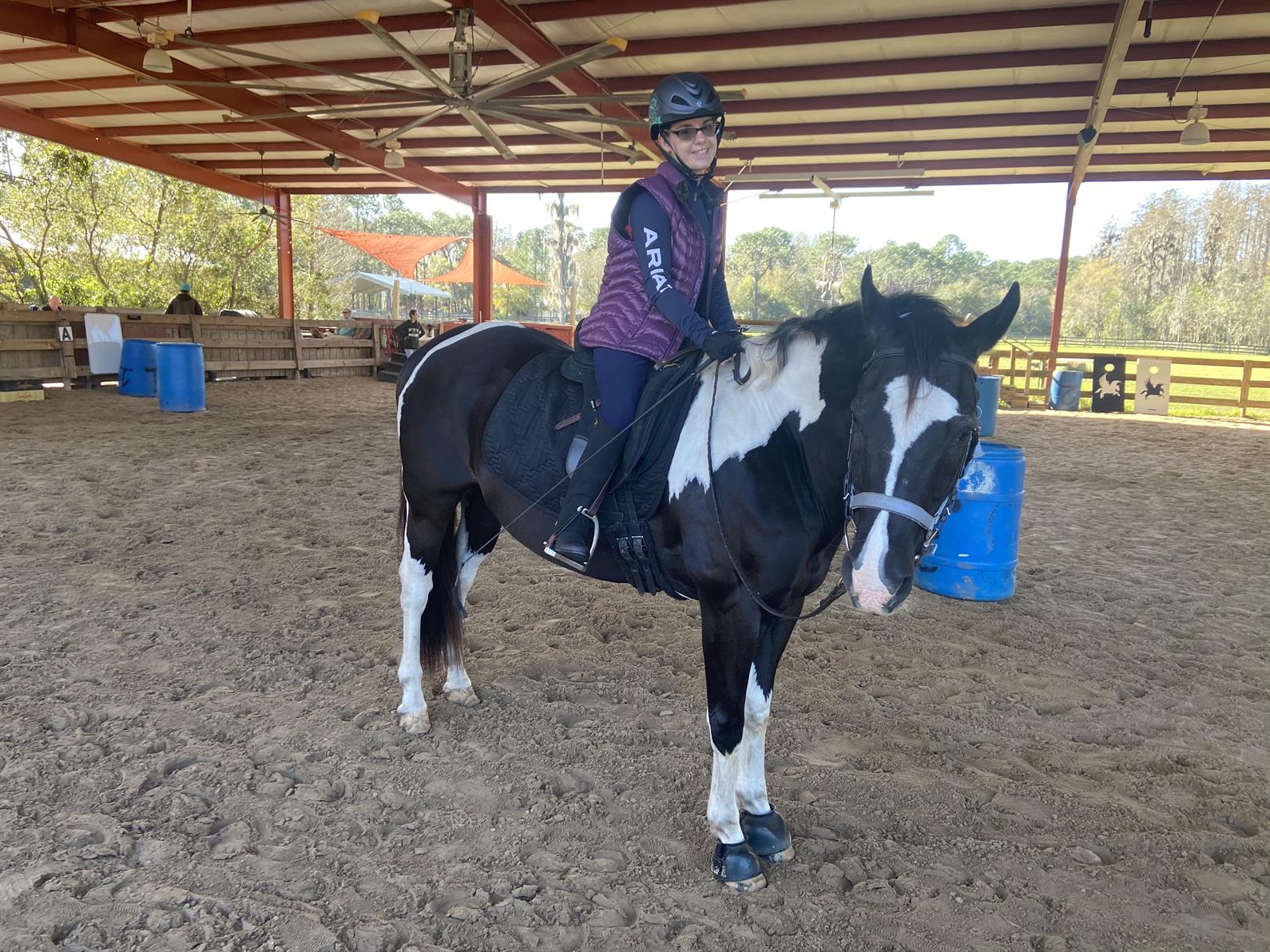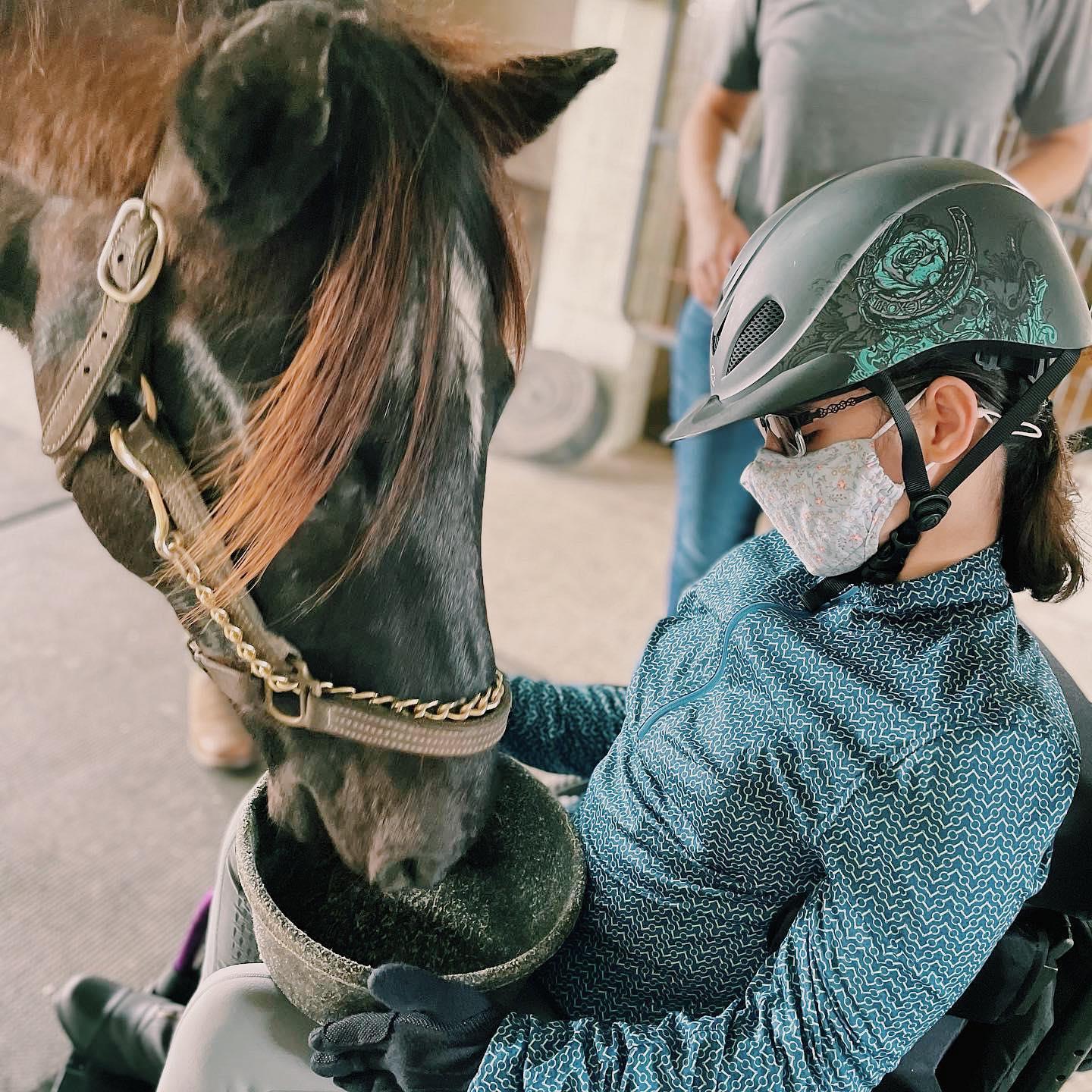Bryanna Tanase is a classified Grade I para dressage rider who rides at Quantum Leap Farm in Odessa, Fla., and Emerald M Therapeutic Riding Center in Brooksville, Fla. She hopes to someday secure a place on the Adequan® U.S. Para Dressage Team and ride at the Paralympics, as well as at other recognized events. She currently rides a Welsh-Thoroughbred cross named Cappy and an American Paint Horse named Shane.
Join the conversation by posting your story with #IAmUSEquestrian or submitting it to us at [email protected].
March is Cerebral Palsy Awareness Month. As a proud Grade I para dressage rider and USEF adult amateur living with cerebral palsy, I want to share with you a little bit about my diagnosis, how it affects the way I ride and compete, how horses have helped me to cope with the effects CP has on my life, and how you can support CP awareness and research during Cerebral Palsy Awareness Month and beyond.

Photo: Courtesy of Bryanna Tanase
CP is a congenital neurological disability caused by brain damage before or during birth that affects movement, balance, coordination, and muscle control. I was diagnosed with spastic diplegia at 11 months old. This is the most common type of CP, resulting from damage to the motor cortex and affecting the lower body more than the upper body. There are multiple types of CP depending on the area of the brain that is damaged, and each of these has varying levels of severity. My CP is on the more severe side of the spectrum, so I use a wheelchair for all my mobility and require help with most activities of daily living. Despite the challenges my CP presents to me, the horses in my life remind me of my power and my abilities.
How Riding is Different with CP
Being an equestrian with CP is certainly different from the “typical” equestrian experience. One of the biggest differences in the way that I ride comes from the fact that, due to my disability, the connection between my brain and my spinal cord is severed, and the messages my nervous system sends take longer to reach my muscles.
So, while I am riding, I often need to tell my body what to do using my inner voice and visualize myself doing it to help the message come across better. For example, if my instructor tells me to bring my elbows back, I repeat it to myself in my mind and then visualize myself doing it as I initiate the action. I do this while I am paying attention to my horse’s pace and making sure we are going the right direction.
Another difference is that if I want to try a movement like a leg yield at the walk, I must adapt the movement to a gentle whip cue instead of using my leg.
Perhaps the biggest difference is the way that I mount and dismount: using either a special lift that takes me on and off the horse or by doing a stand and pivot transfer from a mounting ramp. A mounting ramp is either a wooden or metal ramp that is portable or built into the side of the arena near the entrance that is used to help those with impairments mount a horse safely. The ramp is the proper height so that a rider can easily transfer onto the horse’s back on their own or with assistance. A stand and pivot transfer is a commonly used technique for those with mobility impairments on a mounting ramp, whereby the rider is assisted by two or more people to stand up out of their chair, walk over to the horse, turn to side-sit on the saddle and swing their leg over the horse’s other side. Stand and pivot transfers are also used for every day activities.
CP also affects my ability to attend and ride at competitions. This is mostly because the venues near me are inaccessible and not wheelchair friendly. To compete away from home, I will have to bring a whole team with me and come up with a super-creative way to mount. Safe travel over long distances to far-away shows is an issue that my team and I have yet to figure out. Thankfully, virtual shows and judging have been a godsend to come out of the pandemic, and I have been able to compete without leaving the facilities where I train. Shane and I even got a 55% on our first professionally judged dressage test through the USEF/United States Para-Equestrian Association virtual judging program. Cappy and I are also entering our first virtual show together. I know we will only get better and stronger from here!
Horses Are Empowering
Horses are a huge source of empowerment and comfort to me. Often, I am told what I can’t or shouldn’t do because I have cerebral palsy, but with horses I am reminded that I can do more than others or even I believe.

Photo: Courtesy of Bryanna Tanase
People with CP and other disabilities are often socially isolated and ostracized because of their differences. Horses have given me a social community and people to connect with that I would not meet otherwise. I am so grateful for all the amazing people I have met because of horses and the support team I have built. They have helped me with my emotional and mental health by helping me smile and laugh when things are not going well. My physical health has also drastically improved because of riding. I feel stronger, have better balance and coordination, and have developed a proper sense of body awareness, which is beneficial for every part of my life.
When I am not riding or around horses, I am passionately advocating for the greater inclusion of para-equestrians in equestrian media and the industry at large through social media and writing articles for equestrian media outlets such as US Equestrian magazine and Kerrits Performance Equestrian Apparel's Inclusivity Project. Ableism—the favoring of able-bodied people—is apparent in the horse industry, and I am working tirelessly to create positive change and to educate others about disability and para-equestrianism.
Para-equestrians put in so much effort every day to reach our goals, even on days when our impairments are working against us. We are just as capable as our able-bodied counterparts; we just need a space that is welcoming and accessible to us so that we can reach our full potential. Support not only the athletes at the top but the ones striving to get there. If riding is not an option, allow us to help with grooming, leading, office tasks, and other necessary parts of barn life as we are able to. We may surprise you.
We are so much more than our disabilities. We are real people who have goals and dreams, and we work hard to achieve them every day. The barn should be a place where people from all walks of life are accepted as they are, regardless of ability and experience. Horses and horse sports are for everyone.
Want to learn more about CP and para-equestrianism? Check out these resources online:
Cerebral Palsy Alliance Foundation
United States Para-Equestrian Association
USEF Learning Center video: Pathway to Para-Equestrian Dressage


